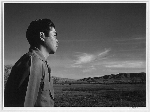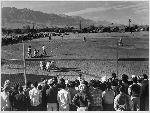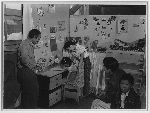The Prints and Photographs Division of the Library of Congress holds a rare set of photographs by Ansel Adams (1902-1984) documenting Japanese Americans interned at the Manzanar War Relocation Center. Adams donated 209 photographic prints and 242 original negatives of Manzanar to the Library between 1965 and 1968. In "Suffering under a Great Injustice": Ansel Adams's Photographs of Japanese-American Internment at Manzanar, the entire collection appears online for the first time. The original prints and the original negatives are displayed side by side (with the print on the left and the negative on the right), allowing viewers to see Adams's darkroom technique and in particular how he cropped his prints. The online collection also includes digital images of the first edition of Born Free and Equal, the book Adams based on his work at Manzanar.
Ansel Adams
Ansel Adams, America's best-known photographer, is renowned for his Western landscapes. Best remembered for his views of Yosemite and the Sierra Nevada, he created photographs that emphasize the natural beauty of the land. By contrast, Adams's photographs of people have been largely overlooked. Adams was trained as a musician, but in 1927 he made a photograph—Monolith, the Face of Half-Dome—that changed his career. Later that year he published this dramatic photograph along with seventeen others in his first portfolio, Parmelian Prints of the High Sierras. By 1940, he was an established fine-art photographer. His work had been exhibited in one-person shows at major institutions on both the East and West Coasts, he served on the board of the photography department at the Museum of Modern Art (New York City), and he was offered lucrative commercial assignments.
War Relocation Program
On December 7, 1941, Japan bombed Pearl Harbor. Fear of a Japanese invasion and of subversive acts by Japanese Americans prompted President Franklin D. Roosevelt to sign Executive Order 9066 on February 19, 1942. The order designated the West Coast as a military zone from which "any or all persons may be excluded." Although not specified in the order, Japanese Americans were singled out for evacuation. More than 110,000 people of Japanese ancestry were removed from California, southern Arizona, and western Washington and Oregon and sent to ten relocation camps. Those forcibly removed from their homes, businesses, and possessions included Japanese immigrants, who were legally forbidden to become citizens (Issei); the American-born (Nisei); and children of the American-born (Sansei).
Adams's Work at Manzanar
The internment of Japanese Americans struck a chord with Adams when Harry Oye, his parents' longtime employee and an Issei in poor health, was summarily taken into custody by authorities and sent to a hospital halfway across the country in Missouri. Angered by this event, Adams leapt at an opportunity to photograph Japanese-American internees at the Manzanar War Relocation Center, which was run by his friend and fellow Sierra Club member Ralph Merritt.
Adams had already completed a number of assignments for the military as a civilian, including teaching photography at Fort Ord and photographing Yosemite's Ahwahnee Hotel, which was used as a Navy hospital during the war, but he was anxious for a more meaningful project related to the war effort. His documentation of Manzanar would become his most significant war-related project.
During the fall of 1943, Adams took photographs at the Manzanar War Relocation Center, which was located at the eastern edge of the Sierra Nevada mountains, approximately two hundred miles northeast of Los Angeles in Inyo County, California. The series was a departure from his usual landscape photography. Adams produced an essay on the Japanese Americans interned in this beautiful but remote and undeveloped region where the mountains served as both a metaphorical fortress and an inspiration for the internees. Concentrating on the internees and their activities, Adams photographed family life in the barracks; people at work—welders, farmers, and garment makers; and recreational activities such as baseball and volleyball games.
In 1944, a selection of these images along with text by Adams was published by U. S. Camera in a 112-page book, Born Free and Equal. In a letter describing the project to his friend Nancy Newhall, the wife of Beaumont Newhall, curator of photography at the Museum of Modern Art, Adams wrote: "Through the pictures the reader will be introduced to perhaps twenty individuals…loyal American citizens who are anxious to get back into the stream of life and contribute to our victory." The book received positive reviews and made the San Francisco Chronicle's bestseller list for March and April of 1945.
In addition to his work at the camp, Adams photographed the mountains near Manzanar. He made two of his most famous landscape photographs during his visit to Manzanar: Mount Williamson, the Sierra Nevada, from Manzanar, California, 1944 and Winter Sunrise, the Sierra Nevada, from Lone Pine, California, 1944. These dramatic photographs were not included in his gift of Manzanar material to the Library of Congress.
Adams was not the only photographer to work at Manzanar. One of the internees, Toyo Miyatake, had worked as a Los Angeles portrait photographer before he was moved to Manzanar. Although the internees were not allowed to have cameras, Miyatake fashioned one from parts he brought with him in his luggage. Both Adams's and Miyatake's photographs present a positive view of the Japanese Americans interned at Manzanar. In contrast, Dorothea Lange, who had earned her reputation as a social documentary photographer with images of migrant farm workers made during the Depression, worked for the War Relocation Authority photographing the evacuation of Japanese Americans and their arrival at Manzanar. Lange's vision is strikingly unlike those of Adams and Miyatake. She photographed the upheaval of the evacuation and the bleak conditions of the internment camps.
"A Grave Injustice": A Congressional Apology
In 1988, Congress implemented the Civil Liberties Act, apologizing on behalf of the nation for the "grave injustice" done to persons of Japanese ancestry. Congress declared that the internments had been "motivated largely by racial prejudice, wartime hysteria, and a failure of political leadership" and authorized $20,000 payments to Japanese Americans who had suffered injustices during World War II.



